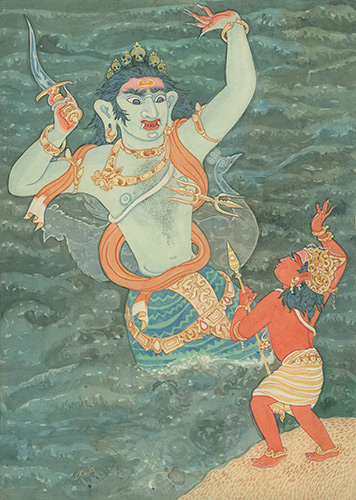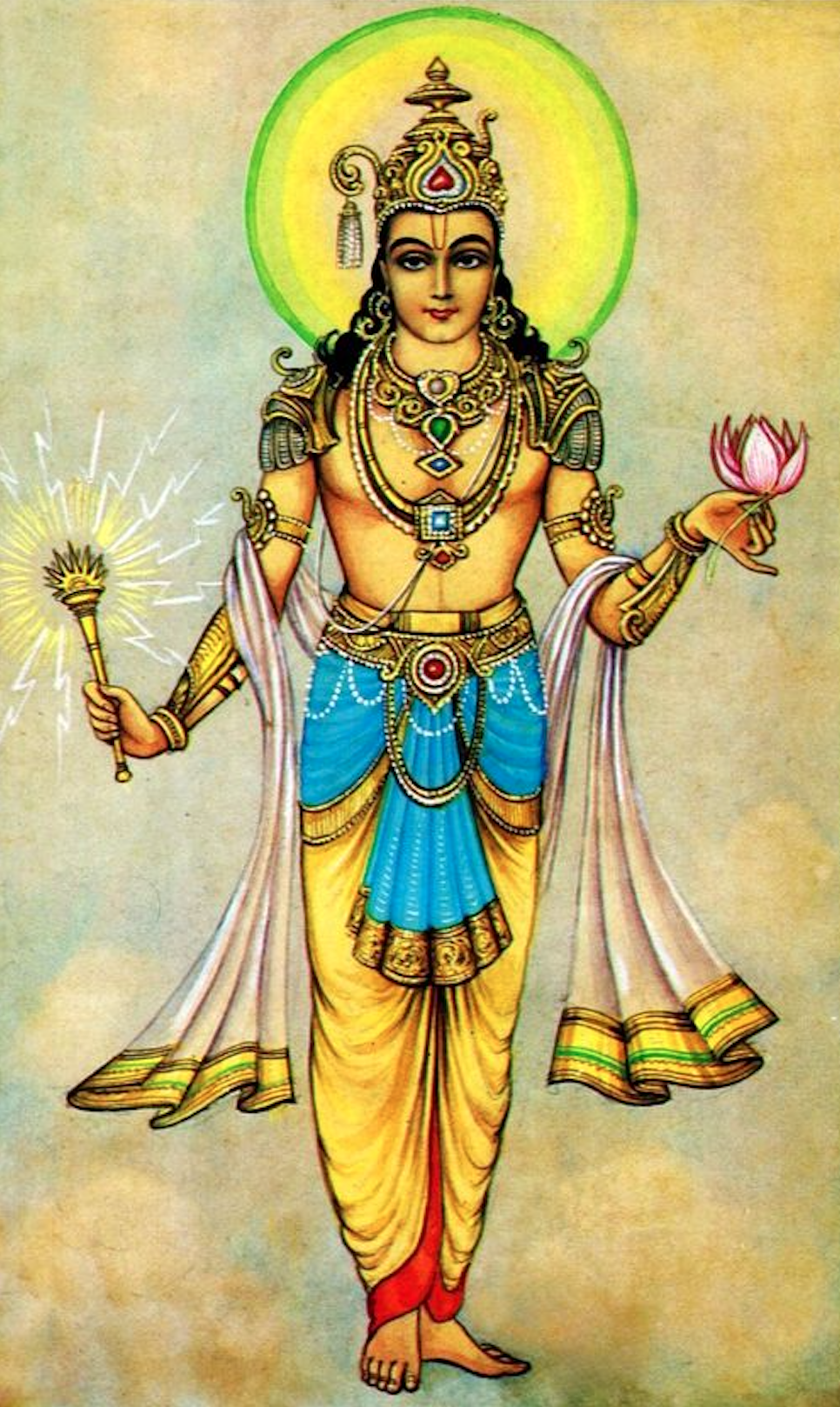|
Weituo
Skanda (), also known as Weituo () and Idaten (Japanese: 韋駄天), is a Mahayana bodhisattva regarded as a devoted guardian of Buddhist monasteries who protects the teachings of Buddhism. He is also sometimes called in the Chinese tradition "Hufa Weituo Zuntian Pusa", meaning "Honored Dharma Protector Weituo Bodhisattva", because he is one of the twenty-four celestial guardian deities mentioned in the ''Golden Light Sutra''. In Chinese temples, Weituo faces the statue of the Buddha in the main shrine, traditionally unarmed and with his hands in anjali. In others, he is on the far right of the main shrine with weapon in hand, whereas on the left is his counterpart, Qielan (personified as the historical general Guan Yu). In Chinese sutras, his image is found at the end of the sutra, a reminder of his vow to protect and preserve the teachings. According to legends, Skanda was the son of a virtuous king who had complete faith in Buddha's teachings. When the Buddha entered Nirv ... [...More Info...] [...Related Items...] OR: [Wikipedia] [Google] [Baidu] |
Kartikeya
Kartikeya (/Sanskrit phonology, kɑɾt̪ɪkejə/; ), also known as Skanda (Sanskrit phonology, /skən̪d̪ə/), Subrahmanya (/Sanskrit phonology, sʊbɾəɦməɲjə/, /ɕʊ-/), Shanmukha (Sanskrit phonology, /ɕɑnmʊkʰə/) and Murugan (/Sanskrit phonology, mʊɾʊgən/), is the Hinduism, Hindu List of war deities, god of war. He is generally described as the son of the deities Shiva and Parvati and the brother of Ganesha. Kartikeya has been an important deity in the Indian subcontinent since Vedic period, ancient times. Mentions of Skanda in the Sanskrit literature data back to fifth century BCE and the mythology relating to Kartikeya became widespread in North India around the second century BCE. Archaeological evidence from the first century CE and earlier shows an association of his iconography with Agni, the Hindu god of fire, indicating that Kartikeya was a significant deity in early Hinduism. He is hailed as the "favoured god of the Tamils", and the tutelary dei ... [...More Info...] [...Related Items...] OR: [Wikipedia] [Google] [Baidu] |
Pinyin
Hanyu Pinyin, or simply pinyin, officially the Chinese Phonetic Alphabet, is the most common romanization system for Standard Chinese. ''Hanyu'' () literally means 'Han Chinese, Han language'—that is, the Chinese language—while ''pinyin'' literally means 'spelled sounds'. Pinyin is the official romanization system used in China, Singapore, Taiwan, and by the United Nations. Its use has become common when transliterating Standard Chinese mostly regardless of region, though it is less ubiquitous in Taiwan. It is used to teach Standard Chinese, normally written with Chinese characters, to students in mainland China and Singapore. Pinyin is also used by various Chinese input method, input methods on computers and to lexicographic ordering, categorize entries in some Chinese dictionaries. In pinyin, each Chinese syllable is spelled in terms of an optional initial (linguistics), initial and a final (linguistics), final, each of which is represented by one or more letters. Initi ... [...More Info...] [...Related Items...] OR: [Wikipedia] [Google] [Baidu] |
Golden Light Sutra
The Golden Light Sutra or (; ) is a Buddhist text of the Mahayana branch of Buddhism. In Sanskrit, the full title is ''Suvarṇaprabhāsottamasūtrendrarājaḥ'' "The King of Sutras on the Sublime Golden Radiance" History The sutra was originally written in India in Sanskrit and was translated several times into Chinese by Dharmakṣema and others, and later translated into Tibetan and other languages. Johannes Nobel published Sanskrit and Tibetan editions of the text. The sutra is influential in East Asia. The name of the sutra derives from the chapter called "The Confession of the Golden Drum", where the bodhisattva Ruchiraketu dreams of a great drum that radiates a sublime golden light, symbolizing the dharma or teachings of Śākyamuni Buddha. The ''Golden Light Sutra'' became one of the most important sutras in China and Japan because of its fundamental message, which teaches that the Four Heavenly Kings ( zh, t=四大天王, p=Sì Dàtiānwáng) protect the ruler w ... [...More Info...] [...Related Items...] OR: [Wikipedia] [Google] [Baidu] |
Hinduism
Hinduism () is an Hypernymy and hyponymy, umbrella term for a range of Indian religions, Indian List of religions and spiritual traditions#Indian religions, religious and spiritual traditions (Sampradaya, ''sampradaya''s) that are unified by adherence to the concept of ''dharma'', a Ṛta, cosmic order maintained by its followers through rituals and righteous living, as expounded in the Vedas. The word ''Hindu'' is an exonym, and while Hinduism has been called the oldest religion in the world, it has also been described by the modern term ''Sanātana Dharma'' () emphasizing its eternal nature. ''Vaidika Dharma'' () and ''Arya dharma'' are historical endonyms for Hinduism. Hinduism entails diverse systems of thought, marked by a range of shared Glossary of Hinduism terms, concepts that discuss God in Hinduism, theology, Hindu mythology, mythology, among other topics in Hindu texts, textual sources. Hindu texts have been classified into Śruti () and Smṛti (). The major Hin ... [...More Info...] [...Related Items...] OR: [Wikipedia] [Google] [Baidu] |
Vajra
The Vajra (, , ), is a legendary and ritualistic tool, symbolizing the properties of a diamond (indestructibility) and a thunderbolt (irresistible force). It is also described as a "ritual weapon". The use of the bell and vajra together as symbolic and ritual tools is found in all schools of Tibetan Buddhism. The vajra is a round, symmetrical metal scepter with two ribbed spherical heads. The ribs may meet in a ball-shaped top, or they may be separate and end in sharp points. The vajra is considered inseparable from the bell, and both are sold in dharma stores only in matching sets. The bell is also metal with a ribbed spherical head. The bell also depicts the face of Dhatvisvari, a female buddha and the consort of Akshobhya. The vajra has also been associated as the weapon of Indra, the Vedic king of the Deva (Hinduism), devas and Svarga, heaven. It is used symbolically by the dharma, dharmic traditions of Hinduism, Buddhism, and Jainism, often to represent firmness of spir ... [...More Info...] [...Related Items...] OR: [Wikipedia] [Google] [Baidu] |
Investiture Of The Gods
''The Investiture of the Gods'', also known by its Chinese titles () and is a 16th-century Chinese novel and one of the major Written vernacular Chinese, vernacular Chinese works in the gods and demons (''shenmo'') genre written during the Ming dynasty (1368–1644). Consisting of 100 chapters, it was first published in book form between 1567 and 1619. Another source claims it was published in a finalized edition in 1605. The work combines elements of history, folklore, mythology, legends and fantasy.Chew, Katherine Liang (2002). ''Tales of the Teahouse Retold: Investiture of the Gods''. Page XI. . The story is set in the era of the decline of the Shang dynasty (1600–1046 BC) and the rise of the Zhou dynasty (1046–256 BC). It intertwines numerous elements of Chinese mythology, Chinese folk religion, Chinese Buddhism, Confucianism, and Taoism, including deities, demons, immortals and spirits. The authorship is attributed to Xu Zhonglin (novelist), Xu Zhonglin. Pl ... [...More Info...] [...Related Items...] OR: [Wikipedia] [Google] [Baidu] |
Ming Dynasty
The Ming dynasty, officially the Great Ming, was an Dynasties of China, imperial dynasty of China that ruled from 1368 to 1644, following the collapse of the Mongol Empire, Mongol-led Yuan dynasty. The Ming was the last imperial dynasty of China ruled by the Han people, the majority ethnic group in China. Although the primary capital of Beijing fell in 1644 to a rebellion led by Li Zicheng (who established the short-lived Shun dynasty), numerous rump state, rump regimes ruled by remnants of the House of Zhu, Ming imperial family, collectively called the Southern Ming, survived until 1662. The Ming dynasty's founder, the Hongwu Emperor (1368–1398), attempted to create a society of self-sufficient rural communities ordered in a rigid, immobile system that would guarantee and support a permanent class of soldiers for his dynasty: the empire's standing army exceeded one million troops and the naval history of China, navy's dockyards in Nanjing were the largest in the world. H ... [...More Info...] [...Related Items...] OR: [Wikipedia] [Google] [Baidu] |
Mara (demon)
Mara,, '; ; or ; ; also マーラ, ''Māra'' or 天魔, ''Tenma''; ; ; Tibetan Wylie: ''bdud''; ; ; ; in Buddhism, is a malignant celestial Asura king who tried to stop The Buddha, Prince Siddhartha from Awakening by trying to seduce him with his celestial Army and a vision of beautiful women who, in various legends, are often said to be Mara's daughters. In Buddhist cosmology, Mara is associated with death, rebirth and desire. Nyanaponika Thera has described Mara as "the personification of the forces antagonistic to enlightenment." He is Yama's fearsome persona and all beings associated with him, darkness and death, become forces of Mara. These forces consist of Asuras, Rakshasa, Pishacha, Pisacas, Aratis and animals. Origin His name is first mentioned in the ''Atharvaveda, Atharva Veda'' (1200 BCE–1000 BCE) as Mrtyu and Agha Mara, the evil slayer. He is called the "evil one who kills" and "Papiyan", denoting a being which is not only morally bad but intertwined wit ... [...More Info...] [...Related Items...] OR: [Wikipedia] [Google] [Baidu] |
Sangha
Sangha or saṃgha () is a term meaning "association", "assembly", "company" or "community". In a political context, it was historically used to denote a governing assembly in a republic or a kingdom, and for a long time, it has been used by religious associations, including Buddhists, Jains and Sikhs. Given this history, some Buddhists have stated that the tradition of the ''sangha'' represents humanity's oldest surviving democratic institution. In Buddhism, ''sangha'' refers to the monastic communities of ''bhikkhu'' (monks) and '' bhikkhuni'' (nuns). These communities are traditionally referred to as the ''bhikkhu-sangha'' or the ''bhikkhuni-sangha''. As a separate category, those Buddhists who have attained any of the four stages of enlightenment, whether or not they are members of the monastic community, are referred to as the ''āryasaṅgha'' ("noble Sangha"). According to the Theravada school and Nichiren Shoshu Buddhism, the term ''sangha'' does not refer to ... [...More Info...] [...Related Items...] OR: [Wikipedia] [Google] [Baidu] |
Nirvana
Nirvana, in the Indian religions (Jainism, Hinduism, Buddhism, and Sikhism), is the concept of an individual's passions being extinguished as the ultimate state of salvation, release, or liberation from suffering ('' duḥkha'') and from the cycle of birth and rebirth ('' saṃsāra''). In Indian religions, nirvana is synonymous with ''moksha'' and ''mukti''. All Indian religions assert it to be a state of perfect quietude, freedom, and highest happiness; liberation from attachment and worldly suffering; and the ending of ''samsara'', the cycle of existence.Gavin Flood, ''Nirvana''. In: John Bowker (ed.), '' Oxford Dictionary of World Religions'' However, non-Buddhist and Buddhist traditions describe these terms for liberation differently. In Hindu philosophy, it is the union of or the realization of the identity of Atman with Brahman, depending on the Hindu tradition. In Jainism, nirvana is also the soteriological goal, representing the release of a soul from karmic bondage ... [...More Info...] [...Related Items...] OR: [Wikipedia] [Google] [Baidu] |
Faith In Buddhism
In Buddhism, faith (, ) refers to a serene commitment to the practice of Gautama Buddha, the Buddha's teaching, and to trust in enlightened or highly developed beings, such as Buddha (title), Buddhas or ''bodhisattvas'' (those aiming to become a Buddha). Buddhists usually recognize multiple objects of faith, but many are especially devoted to one in particular, such as one particular Buddha. Faith may not only be devotion to a person, but exists in relation to Buddhist concepts like the efficacy of karma (Buddhism), karma and the possibility of enlightenment (Buddhism), enlightenment. Faith in Early Buddhist schools, early Buddhism focused on the Triple Gem, that is: the Buddha; his teaching (the Dharma (Buddhism), dharma); and the community of spiritually developed followers or the monastic community seeking enlightenment (the saṅgha). A faithful devotee was called an upasaka and Upasika, or , a status for which no formal initiation was required. Early Buddhism valued ... [...More Info...] [...Related Items...] OR: [Wikipedia] [Google] [Baidu] |







